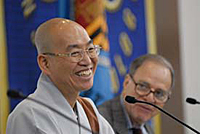Eugene Bell Foundation
Fall 2007 newsletter
Medical Support for Individual Patients Now Possible
The Eugene Bell Foundation, a non-governmental organization that provides medical support for North Korean tuberculosis (TB) patients, announces that countermeasures are urgently needed for the recent increase of multi-drug resistant tuberculosis (MDR-TB) patients in North Korea.
After years of visiting and providing TB medicines for TB Care Centers in North Korea, EugeneBell estimates that over 30% of all TB patients in the country may be infected with MDR-TB. Evidence suggests the number of patients is increasing year-by-year.
In response to this growing crisis, the delegation visited six different North Korean TB Care Centers in early 2007 and collected sputum samples from 20 patients thought to be infected with MDR-TB and brought them to South Korea for study. The test results identified at least two or more strains of MDR-TB virus in over 60% of the samples.
In response, EugeneBell began a support program for MDR-TB patients when a delegation returned to North Korea (November 15 – 27, 2007). This fall, a follow-up delegation delivered a six-month supply of special MDR TB medication for the patient’s diagnosed with multi-drug resistant tuberculosis.
As part of the new support program, EugeneBell and North Korean medical authorities have agreed to establish special wards for multi-drug resistant patients in four long-term care facilities. One center will be located in each of the following locations: North Pyongan Province, South Pyongan Province, Nampo City and Pyongyang City. These MDR wards will serve as centers for treating patients who do not respond to regular tuberculosis medications.
“Multi-drug resistant tuberculosis is a deadly, contagious disease that can spread resistant strains of tuberculosis that are extremely difficult and expensive to treat,” states Dr. Linton, EugeneBell Chairman. “Because MDR-TB threatens the health of every citizen, steps must be taken as soon as possible to meet this challenge.”
Unfortunately, even short-term countermeasures to meet the spread of MDR-TB in North Korea are difficult because no in-country testing facilities are available today. An even greater barrier to an effective national MDR program is the high cost of MDR medications. While it takes only six months to treat and cure a case of ordinary TB, MDR-TB requires at least 18 month, and special drugs that cost nearly 100 times as much as regular tuberculosis medications. In order to solve such difficulties, EugeneBell will initiate a ‘One-by-One MDR-TB Patient Support Program’ beginning in 2008. This program will connect one patient in North Korea with individual donors to insure that each patient in the program receives the necessary support for long-term treatment.
Dr. Linton notes, “This small but significant start toward an effective MDR-TB program for people in North Korea that will begin with 20 patients and grow as additional support becomes available. Every human life is precious. While we hope we can eventually reach all MDR patients in North Korea, just saving one person who would otherwise die from this dreaded disease is well worth the effort.”
“North Korean medical professionals are delighted with the new program. Doctors who formerly had no effective way of helping their patients who failed to respond to ordinary tuberculosis medications now have hope that even the most ill tuberculosis patient may be saved. The enthusiasm with which they pitch in to collect sputum samples from their most difficult cases is heart-warming” continues Dr. Linton.
Dr. Park Seung-kyu, Director of Masan National Tuberculosis Hospital in South Korea, will make his hospital’s state-of-the-art research facilities available for testing sputum samples from North Korea. “As a matter of fact, MDR-TB is considered a serious problem not only for North Korea but also for South Korea and the world,” says Dr. Park. “There is a need for experts from both South and North Korea to discuss countermeasures together for the treatment of MDR-TB on the Korean Peninsula”
A EugeneBell delegation just returned from visiting thirteen medical institutions located in North Pyongan Province and Pyongyang City. Next spring, a follow-up delegation will deliver medications for the patients who provided samples this autumn.
EugeneBell also started two other pilot programs in 2007, one for mothers and infants and another for school-aged children. These will provide a steady stream of assistance through ‘Mother and Infant Packages’ and ‘Children’s Health Packages’ to three local hospitals, one in North Pyongan Province and two in South Pyongan Province.

